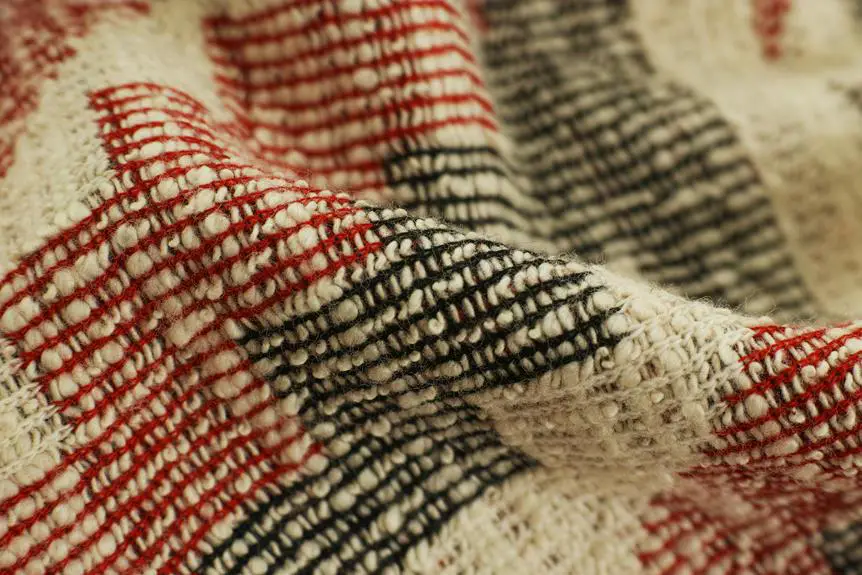You're likely no stranger to Poly Tricot fabric if you're an athlete or fitness enthusiast. It's a popular choice for sportswear due to its perceived breathability and moisture-wicking properties. But have you ever stopped to think about whether it really lives up to the hype? As you consider your next activewear purchase, it's worth examining the facts. How does Poly Tricot's unique weave and fabric composition impact its breathability, and how does it compare to other fabrics on the market? The answer might just influence your next gear upgrade – and your performance.
Table of Contents
What Is Poly Tricot Fabric
So, exactly what is poly tricot fabric, and how does it differ from other synthetic materials?
As someone looking to understand the fabric, you're likely curious about its composition and characteristics. Poly tricot fabric is a type of synthetic fabric made from polyester. It's created using a tricot knitting process, which produces a soft, smooth, and lightweight fabric. Unlike other synthetic materials, poly tricot fabric has a unique texture that's often described as silky or velvety.
You might be wondering how poly tricot fabric compares to other popular synthetic fabrics like nylon or spandex. One key difference is its durability. Poly tricot fabric is resistant to wrinkles and can withstand repeated washing and wear without losing its shape.
It's also easy to care for, as it can be machine washed and dried. Additionally, poly tricot fabric is often less expensive than other synthetic fabrics, making it a popular choice for activewear and sportswear.
Breathability in Sportswear Fabrics
When you choose sportswear fabrics, you're likely looking for materials that keep you cool and dry during intense activities. Breathability is key in these fabrics, and it's often achieved through moisture management systems that wick away sweat and air permeability testing that measures how well fabrics allow air to pass through.
You might be wondering how poly tricot fabric stacks up in terms of breathability, so let's explore the specifics of moisture management systems and air permeability testing in sportswear fabrics.
Moisture Management Systems
As you engage in high-intensity activities, your sportswear's ability to manage moisture becomes crucial, and that's where moisture management systems come in – integrated technologies that enhance breathability in sportswear fabrics.
These systems are designed to keep you dry and comfortable by controlling the rate at which moisture is absorbed, transported, and evaporated. By doing so, they help regulate body temperature and prevent overheating.
Moisture management systems typically involve special treatments or finishes applied to the fabric. These treatments can be chemical-based, like water-repellent coatings, or physical, like mesh panels for ventilation.
Some sportswear fabrics even incorporate phase-change materials that absorb and release heat as needed. As you move and sweat, these systems work together to wick away moisture, allowing it to evaporate quickly and efficiently.
When shopping for sportswear, look for fabrics with built-in moisture management systems. These high-tech fabrics can make a big difference in your performance and comfort level.
Air Permeability Testing
You can measure the breathability of sportswear fabrics using air permeability testing, a standardized method that assesses how easily air passes through a fabric. This test is crucial in determining a fabric's ability to release moisture, a key factor in preventing the buildup of sweat during intense physical activity.
When you conduct an air permeability test, you'll typically use a device that applies a set amount of pressure to a fabric sample. The device then measures the airflow that passes through the fabric, usually in units of liters per second.
When it comes to interpreting air permeability test results, a higher value usually indicates greater breathability. For instance, a fabric with high air permeability is better suited for sportswear applications, such as running shirts or athletic jerseys, where moisture management is essential.
On the other hand, fabrics with lower air permeability might be better suited for colder weather sports, where wind and cold resistance take priority over breathability. By analyzing air permeability test results, you can determine if poly tricot is breathable enough for sportswear applications and if it can keep you cool and dry during intense exercise.
Poly Tricot Moisture Management
Poly Tricot's moisture management capabilities are crucial to its breathability, and it's able to wick away moisture from your skin relatively quickly.
This is because Poly Tricot is a synthetic fabric that's designed to draw moisture away from the skin and allow it to evaporate quickly.
When you're engaging in high-intensity activities, this feature is especially important, as it helps to keep you dry and comfortable.
Rapid moisture transfer is one key benefit, where Poly Tricot's fabric structure allows moisture to transfer quickly from the skin to the surface of the fabric, where it can evaporate.
Reduced clinginess is another advantage, as wicking away moisture reduces the likelihood of clinginess, which can be uncomfortable and distracting during exercise.
Improved comfort is also achieved through Poly Tricot's moisture management capabilities, as they help to regulate body temperature, keeping you cool in the summer and warm in the winter.
Comparison to Other Fabrics
Comparing Poly Tricot to other fabrics reveals its unique breathability advantages, particularly when stacked against natural fibers like cotton and wool. You might be wondering how Poly Tricot holds up against other popular sportswear fabrics. Let's take a look at the comparison.
| Fabric | Breathability |
|---|---|
| Poly Tricot | High |
| Cotton | Low |
| Wool | Medium |
As you can see, Poly Tricot outperforms cotton and wool in terms of breathability. This is because Poly Tricot is a synthetic fabric that allows for airflow and moisture transfer, making it ideal for high-intensity activities. Cotton, on the other hand, absorbs moisture and can become heavy and uncomfortable during exercise. Wool is a natural insulator, but it can also retain moisture and lose its breathability when wet. Poly Tricot's unique blend of synthetic fibers makes it a top choice for sportswear that requires both performance and comfort. By choosing Poly Tricot, you can stay dry and comfortable during your workout, without sacrificing style or performance.
Effects on Athletic Performance
When it comes to high-intensity activities, wearing a breathable fabric like Poly Tricot can significantly impact your athletic performance by allowing for better airflow and moisture transfer. This means you'll be able to perform at a higher level for longer periods without feeling weighed down by sweat and heat.
Poly Tricot's breathability helps regulate your body temperature, keeping you cooler in the summer and warmer in the winter.
As an athlete, you know how important it's to stay focused and comfortable during competition. Wearing Poly Tricot can give you a mental edge by reducing distractions caused by discomfort or overheating.
- Improved endurance: By keeping you cooler and drier, Poly Tricot helps you maintain your energy levels over longer periods.
- Enhanced agility: With a full range of motion and no restrictive, sweat-soaked fabric, you'll be able to move more freely and quickly.
Alternatives for Breathable Sportswear
Several alternatives for breathable sportswear exist that offer similar benefits to Poly Tricot, so you can choose the one that best fits your needs and preferences.
You might consider moisture-wicking fabrics like polyester blends, nylon, or wool. These materials are known for their breathability and ability to keep you dry and comfortable during workouts.
Another option is mesh panels, which can be added to your sportswear to enhance ventilation and airflow.
You can also look for sportswear made from natural fibers like bamboo or cotton, which are breathable and eco-friendly.
Additionally, some sportswear brands incorporate technology like ventilation zones or cooling fabrics to enhance breathability.
When choosing an alternative to Poly Tricot, consider factors like your activity level, the climate you'll be in, and your personal comfort preferences.
Frequently Asked Questions
Can Poly Tricot Be Used for Outdoor Sports in Cold Weather?
You're planning outdoor sports in cold weather and wondering if poly tricot is a good choice. While it provides warmth, its breathability might be a concern. You'll need to weigh its pros and cons for your specific needs.
Is Poly Tricot Fabric Prone to Pilling or Snagging Easily?
You should know that poly tricot fabric can be prone to pilling or snagging, especially if it's made from low-quality materials or weaves. However, high-quality poly tricot can minimize these issues, making it a decent choice.
Can Poly Tricot Be Paired With Other Breathable Fabrics for Sportswear?
You can definitely pair poly tricot with other breathable fabrics to enhance its moisture-wicking properties. Combining it with mesh panels or cotton blends can improve airflow and keep you cool during intense workouts.
Does Poly Tricot Fabric Provide UV Protection for Athletes?
When choosing sportswear for outdoor activities, you'll want to know if the fabric provides UV protection. Poly tricot fabric can offer some level of UV protection, but it's not as effective as specialized UV-blocking fabrics, so you'll need to weigh the benefits.
Can Poly Tricot Be Used for Sportswear That Requires High Compression?
You're considering poly tricot for high-compression sportswear. This fabric is known for its durability and resistance to wrinkles, but it may not provide the necessary stretch or recovery for high-compression garments, you might want to blend it.
- How Does Ring Spun Cotton Affect Garment Fit and Shape Retention? - August 13, 2024
- What Are the Challenges in Producing Ring Spun Cotton? - August 13, 2024
- Is Ring Spun Cotton Suitable for Plus-Size Clothing? - August 13, 2024







